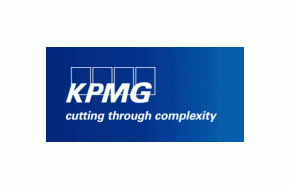
By Gareth Vaughan
Bad loans are almost as rare as hen's teeth and banks aren't expecting the picture to worsen anytime soon, KPMG says in its June quarter Financial Institutions Performance Survey (FIPS).
The auditing and financial advisory firm says at the equivalent of just eight basis points of gross loans and advances, banks' loan impairments are well down on the long-term average of 19 basis points.
"Bad loans are harder to find than a cheap house in Auckland," KPMG says.
And even though asset quality deteriorated in the June quarter, this merely moved the level of impaired loans from minuscule to tiny, adds KPMG.
"In the previous two quarters ended December 31, 2013 and March 2014, the total impairment expense for all sector participants were $7.9 million and $10.7 million respectively, resulting in an almost nil (0.01%) impaired asset expense to gross loans and advances ratio. For the June quarter, this ratio has returned to a more normal level at 0.08%, slightly below the ratios seen pre the (Reserve Bank's ) LVR (restrictions) implementation."
Impaired asset expense did, however, rise $55.5 million, or 522%, in the June quarter to $66.2 million at June 30 from $10.7 million at March 31. This was driven by a $39 million increase at ANZ, $12 million at Westpac, and $11 million at CBA.
"Despite impaired asset expense increasing during the quarter, both the collective provisioning and individual provisioning decreased when compared to the size of their loan books, indicating that overall, banks are confident in the strength of the economy and are expecting less impairment in the future," KPMG says.
"This is further shown by the total provision for doubtful debts over gross loans and advances ratio having reduced every quarter since 31 March 2011, and is now at 0.60% at 30 June 2014. This was mainly driven by reductions of the collective provisioning rather than individual provisioning."
Banks 'riding Reserve Bank OCR rate changes well on the way up'
Meanwhile, of the nine banks surveyed only ANZ recorded a net interest margin fall, down to 2.27% from 2.29% in the March quarter. KPMG attributed the ANZ drop to increased interest expense, and asset pricing pressure. The participants' overall net interest margin rose seven basis points to 2.29%.
"This indicates that overall the sector is riding the Reserve Bank OCR rate changes well on the way up and the growing competitiveness in retail mortgages is still allowing some margin growth," KPMG says.
Interest earning assets for the sector grew 1.22% in the June quarter, versus 1.18% in the March quarter. Most of the growth was driven by ANZ and Westpac, who increased interest earning assets by 3.2% and 1.9%, respectively. Total assets rose to a record high, up 0.83% in the June quarter, and 2.38% year-on-year, to $390 billion.
Removing ANZ's March quarter one-off $91 million insurance settlement, June quarter "normalised" profit across the banks rose 6.2%, KPMG says. When the ANZ one-off is included, June quarter net profit after tax across the banks dropped about $25 million to $1.125 billion.
The FIPS survey covers ANZ, BNZ, Commonwealth Bank of Australia's New Zealand operations including ASB, Heartland Bank, Kiwibank, SBS, the Co-operative Bank, TSB and Westpac.
*The charts below are taken from the FIPS report.
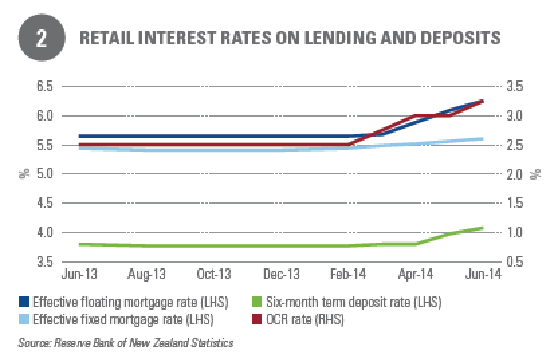
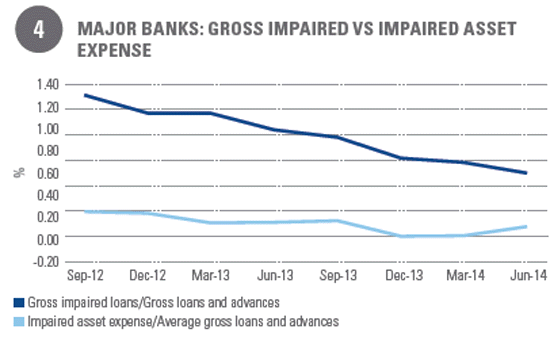
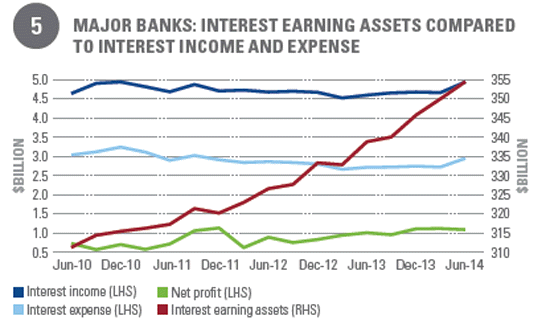
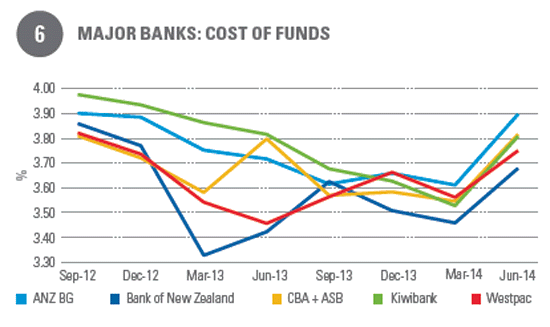
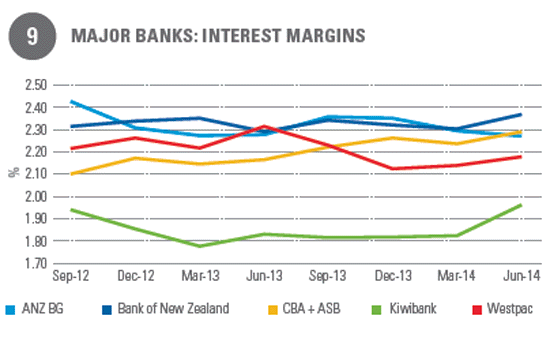
14 Comments
So banks do benefit from rising rates, by gently increasing their margins on the way up.
Despite the bank apologists denying that banks benefit from hikes.
http://www.stuff.co.nz/business/money/10541243/Lending-growth-lifts-ban…
Yes youre right MB, you're a red rag to this bull who can't always reframe from responding to your misinformation. This axctually isn't a case, as the headine might seem to suggest to you, of the banks riding the OCR increases higher than they occur, and thus increasing their margins - it has little to do with what the RBNZ's doing, its all to do with their global cost of funds which are dropping, and they are not passing that reduction onto their borrowers at the same rate as they could be (at least as much as competitive forces dictate). So whilst KPMG know what they're talking about, it misleads somewhat those that know little about interest rates and lead them to the assumption that its the rate hikes causing in rather than the fact that its their reducing costs that actually is. Good on you though for keep trying to educate yourself MB, one day you might not need a comment back...I live for that day.
Please present detailed examples of hedged (cross currency basis swap dets.) foreign borrowings over a time period consistent with your reduced foreign wholesale NZ bank funding claims.
...refrain...
You are joking nzcoolie - back in 2012 and 2013 MB was calling for the OCR to be at 2% now - he was calling for two rate cuts with zero logic to it - I guess it depends what you call wrong, but 150 basis points wrong is about as wrong as you can get it in markets
Stephen - I'm not citing numbers because I don't have access to them with any bank obviously, but are you just interested in the detail or doubting that bank funding costs are falling - I'm sure its not the latter. Certainly swapped funds back into NZ have been coming in well under 100bps now depending upon the term, rather than in the 200's up to a couple of years ago - its the trend
MB - fantastic - youre good at spell checking, well done.
I'm sure its not the latter. Certainly swapped funds back into NZ have been coming in well under 100bps now depending upon the term, rather than in the 200's up to a couple of years ago - its the trend
Hmmmm - I think you will need to add the relevant local NZD term swap rate to that estimate and then a little bit more. Fig. 3.9 Page 19 of 53
Yes the 3 months rolling spreads are about 100bps and heading lower bar some global distruption, but aware of one done in the 80's recently. The trend has been favourable for banks and its borrowers but it has permitted the banks some margin recovery...nothing to do with OCr headline rates rising
kimy-zany-zane is back bashing graeme wheeler
Yes wait for Grant As spin is just around the corner, to think the rock star economy and interest rate cycle last barely six months... Economic commentary this year is the worst I have every lived thru.
Doesn't seem as if the NZ economy needs to be dampened down deliberately (like the alliteration?) anymore. There are plenty of dampening down forces at work without intervention at this stage.
So what happens to bank funding costs with a rising USD? Does NZD weakness open the door for inflationary pressures as well as increased funding costs to banks? Where does that leave the RBNZ if inflation begins to show up in their charts near term?
The Governor is actively encouraging an upward bias in tradable inflation outcomes. I am not sure this activity is prescribed in the Policy Targets Agreement , unless inflation (CPI) falls below the lower parameter, which of course is a mixed rate of both tradable and non- tradable costs.
For the purpose of this agreement, the policy target shall be to keep future CPI inflation outcomes between 1 per cent and 3 per cent on average over the medium term, with a focus on keeping future average inflation near the 2 per cent target midpoint.
Agreed but is that a problem Stephen, he has a range of 1-3% but his actual inflation target is 2% and at this stage he's comfortably below that with tight monetary conditions I.e. He's acting to comply with his mandate and can well afford a somewhat lower NZD to relieve. And certainly the productive sector warrants that much more that than the housing sector who he will not give rate relief to, indeed will give further pain to next year barring a global issue which of course is always possible.
Spidy - don't worry, the two don't go hand in hand generally. If bank funding costs are on the rise there would be another 2007-12 crisis hitting us, and if there's another 2007-12 crisis then the USD would rise and the NZD would fall for sure, but I seriously doubt it would be inflationary (unless of course its a delayed inflationary crisis that was the crisis - that's the hardest to fix as you can't lower rates, but for the moment it's deflation that the world's worried about elsewhere, not inflation rightly or wrongly longer-term).The good part of that is that the banks are now ALOT longer funded, hence why they paid up some much to get it, so it would take quite some time now for that to negatively impact bank funding costs.

We welcome your comments below. If you are not already registered, please register to comment
Remember we welcome robust, respectful and insightful debate. We don't welcome abusive or defamatory comments and will de-register those repeatedly making such comments. Our current comment policy is here.